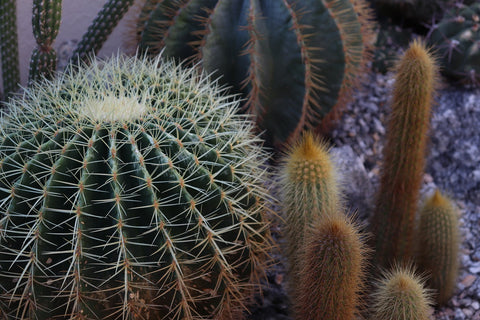You may have once heard some smarty planty pants say: "All cacti are succulents but not all succulents are cacti."
But what did they really mean?
'Succulent’ is a broad term for a group of plant families including Cacti, Agaves, Euphorbias, Sedums, Echeverias and Aloes. All of them have succulent type properties. In other words they contain sap because they evolved in arid conditions to retain water in thick fleshy leaves or stems.
‘Succulent’ comes from the Latin word sucus, meaning sap or juice.
Each family has different properties. For example, with cacti the fleshy sap is stored in the stems not the leaves. Cacti also have sharp spines or needles to keep away grazing animals that would gorge on the sap and suck the plant dry.

Agaves form rosettes with small spikes along the edges of the leaves, and are native to Mexico. The best known Agave is the Blue Agave from which Tequila is made, and grows primarily in the area surrounding the city of Tequila.

Aloes are native to Africa, Madagascar, and the Arabian Peninsula, and the family contains over 500 species of flowering succulent plants. Click here to read more about caring for the De Wet Aloes

All of these plant families falling under ‘succulent’ share certain rules of plant care:
Light
Here’s where you may be surprised – although succulents have adapted to desert conditions, modern hybrids that have grown up in nurseries may prefer part shade or semi-shade during the day, especially as they are acclimatising to their new environment.
Many of the more delicate varieties of Echeverias (rock roses) with their exotic colours can burn if left in all-day sun outdoors and the leaves will start to discolour and shrivel, particularly in our harsh South African climate. Typically, nurseries grow succulents under a light shade net which blocks the harshest rays, but still lets in plenty of light and heat. If you want to plant your succulent in full sun, it may take a few weeks to adjust, during which it will need slightly more water than normal. Cacti, Aloes, Euphorbias and Agaves will adjust faster.
 If growing indoors however, your succulent will enjoy getting a full day’s worth of light filtered through the window. Make sure the plant is near an east or north facing window. If your succulents start growing sideways, it’s not getting enough light and will start to lean towards the sun. It’s also a good idea to rotate them every now and then so they get even light distribution and grow upright. Adequate light is also important for bringing out the best and most vivid colours in your succulent.
If growing indoors however, your succulent will enjoy getting a full day’s worth of light filtered through the window. Make sure the plant is near an east or north facing window. If your succulents start growing sideways, it’s not getting enough light and will start to lean towards the sun. It’s also a good idea to rotate them every now and then so they get even light distribution and grow upright. Adequate light is also important for bringing out the best and most vivid colours in your succulent.
Water
They need more water than you think.
So here’s the deal – a succulent that has grown and adapted to its arid environment (like the Aloe Ferox and Spekboom in the karoo, or the Joshua Tree in Arizona) will be able to withstand longer periods of drought because they’ve had it tough, they’re desert-smart. Smaller potted succulents from nurseries have been babied, weaned, tucked into bed and sung nursery rhymes to, and they just won’t appreciate being thrown out there to fend for themselves.
Watering best practice
Succulents like to have their roots soaked with water but then dry out quickly. Then, watered again after the soil has been dry for a few days.
They will need watering about every week in winter and twice a week in summer.
If you’re unsure, rather underwater.
Cacti can go longer without water than Echeverias, Sedums and Agaves.
Also try to water directly onto the soil. Water on the leaves, although making a pretty picture, can lead to fungal diseases.
Make sure water drains out the bottom of the pot as your succulents do not want to get soggy roots.

Here's a little secret, just like all plants, eventually the lower leaves of succulents are going to shrivel up and die. This is normal and does not necessarily mean it’s drying out. You should only be concerned about dying leaves if the newest or uppermost leaves on your succulent are shriveling.
If it’s just the ones near the bottom of the stem (closest to the soil), you don’t have anything to worry about! Just pluck the shriveled leaves away so the plant can focus its energy on creating new ones from the centre of the rosette.
Potting & re-potting
Never use normal garden soil or potting soil for your succulents. They need a special succulent mix with sand that drains exceptionally well. You may also want to re-pot them into terracotta pots as these are porous, allowing for air and water to move through the walls, preventing soil disease and root rot.

Fertiliser
Succulents don’t need much fertiliser, but you can give them light feedings during the spring and summer growing season. Be careful not to over fertilise—this can cause your succulent to grow too quickly, loose its colours and become weak. Use a slow-release organic fertiliser.
Propagation
Wow this is a fun topic! Succulents are some of the easiest plants to propagate. We’re going to explain this all in detail in a subsequent blog. Stay tuned.
